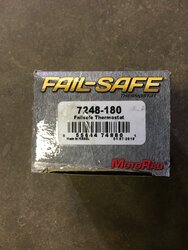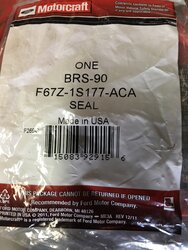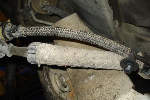- Joined
- April 3, 2008
- Messages
- 3,274
- Reaction score
- 884
- City, State
- Gloucester City, NJ
- Year, Model & Trim Level
- 98 2Dr,2,000 & 04 4dr xlt
Worked a double shift yesterday so not much energy to do anything.
I replaced the fuel filter, it took for ever to get the "quick release fitting hoses" off the old filter.
The old filter was pretty rusty looking so It appeared to be on there for a while.
While I was under there I removed the old rear brake line the had rusted out and was already replaced.
I noticed the new line was rubbing the frame so I secured it in about 4 places and most were original places.
If left the way I found it the frame would have wore through the brake line and there goes all the fluid.
Or it may have vibrated until it cracked. I hate to be critical of others work but brakes are important and peoples lives are riding on them.
I put some wire loom on the spark plugs going to the passenger side. It appears that the cruise control cable rubs the ignition wires.
I noticed when I was removing the old wires that the cable had wore into the insulation a little.
After driving on the new wires for a day there was some rub marks on them so now there is wire loom on them.
I will have to keep an eye on them to make sure no damage happens to the new wires, they are Motorcraft wires and I don't need them failing prematurely.
I replaced the passenger upper ball joint because it had a torn boot. The passenger side lower is brand new.
Moog makes really good front end parts, some which are even better than OEM.
The part number was CK8710T. It is really half the upper control arm and this design even has a replaceable ball joint in the end of it.
It was the most expensive one listed for the passenger side that was still only half the control arm. I did not want to go with the one piece unit.
If I looked it up correctly the replacement ball joint part number is Moog K8738 (for just the removable ball joint)


I replaced the fuel filter, it took for ever to get the "quick release fitting hoses" off the old filter.
The old filter was pretty rusty looking so It appeared to be on there for a while.
While I was under there I removed the old rear brake line the had rusted out and was already replaced.
I noticed the new line was rubbing the frame so I secured it in about 4 places and most were original places.
If left the way I found it the frame would have wore through the brake line and there goes all the fluid.
Or it may have vibrated until it cracked. I hate to be critical of others work but brakes are important and peoples lives are riding on them.
I put some wire loom on the spark plugs going to the passenger side. It appears that the cruise control cable rubs the ignition wires.
I noticed when I was removing the old wires that the cable had wore into the insulation a little.
After driving on the new wires for a day there was some rub marks on them so now there is wire loom on them.
I will have to keep an eye on them to make sure no damage happens to the new wires, they are Motorcraft wires and I don't need them failing prematurely.
I replaced the passenger upper ball joint because it had a torn boot. The passenger side lower is brand new.
Moog makes really good front end parts, some which are even better than OEM.
The part number was CK8710T. It is really half the upper control arm and this design even has a replaceable ball joint in the end of it.
It was the most expensive one listed for the passenger side that was still only half the control arm. I did not want to go with the one piece unit.
If I looked it up correctly the replacement ball joint part number is Moog K8738 (for just the removable ball joint)




























